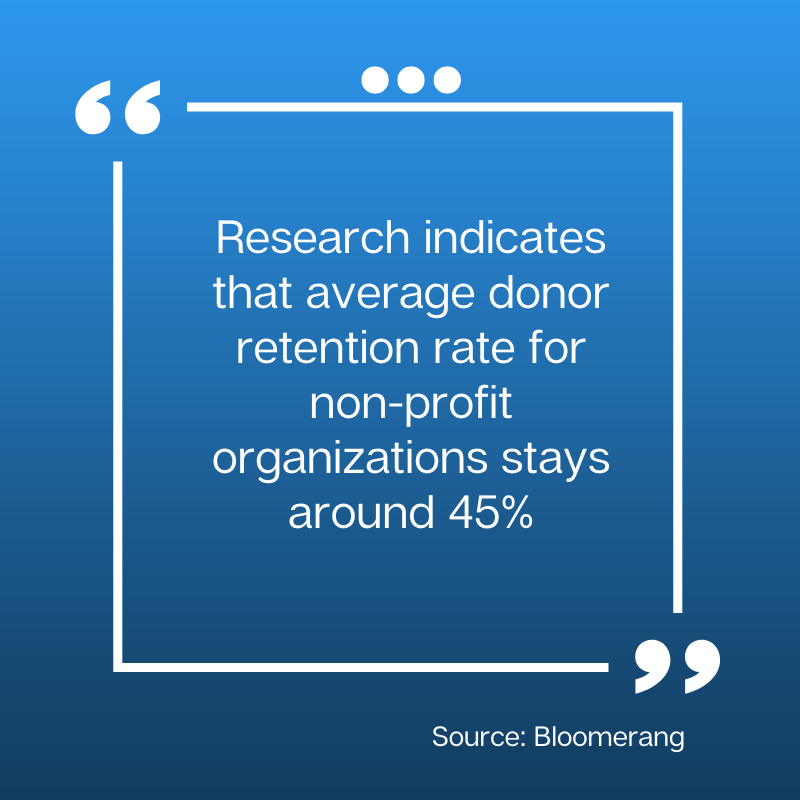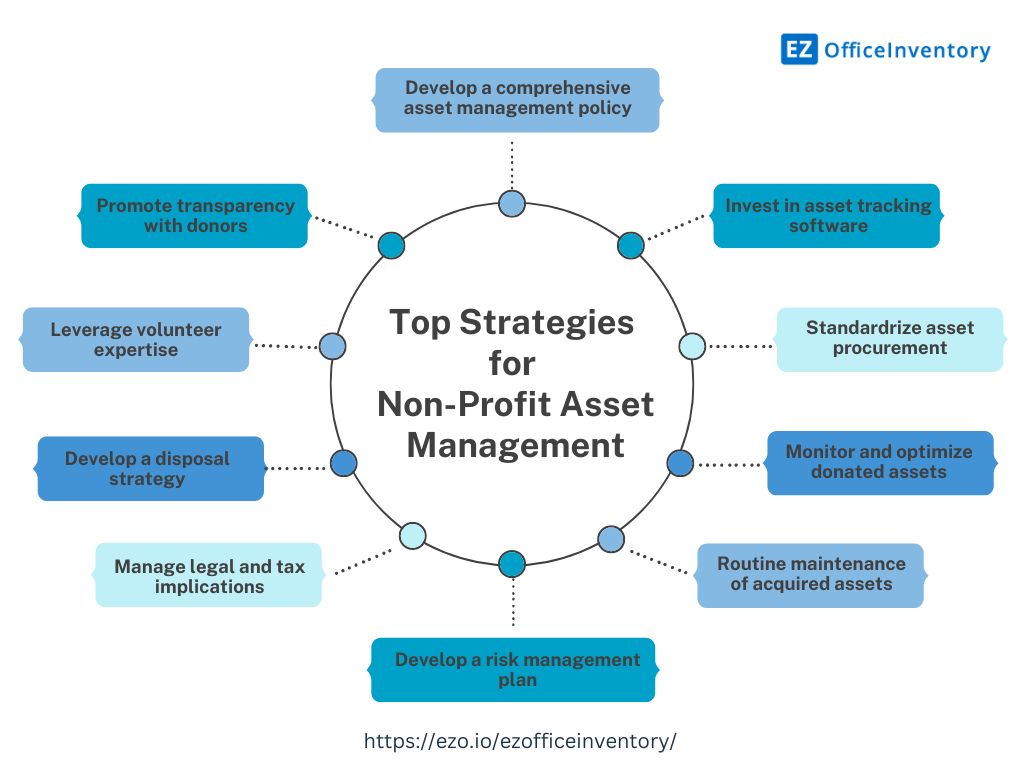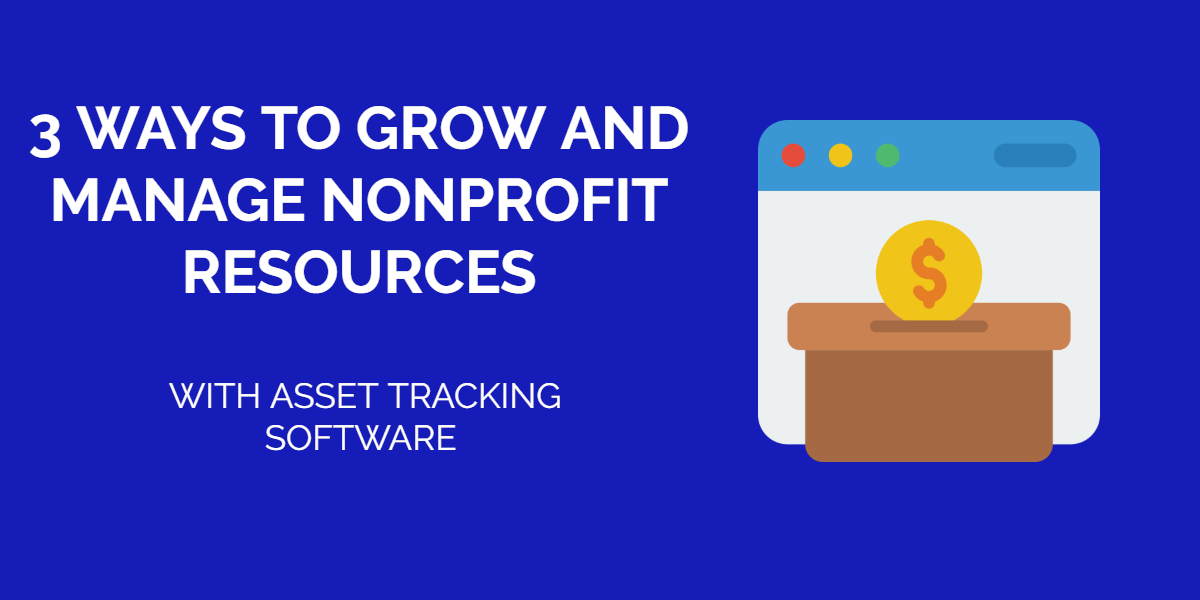Non-profit organizations face unique challenges when it comes to managing their assets. With limited resources and competing priorities, it can be difficult to ensure that assets are being used efficiently and effectively. A 2023 FORVIS report shows that more than a fifth of non-profits operate with cash reserves of three months or less, which is critical. It is, however, possible for non-profits to maximize their impact and achieve their missions by implementing effective asset management strategies.
In this article, we will explore the top 10 strategies for effective non-profit asset management. From conducting regular audits to implementing technology solutions, these strategies will help your organization make the most of its assets and improve its financial health.
What is non-profit asset management?
Non-profit asset management refers to the strategic approach to acquiring, maintaining, and disposing of the various assets owned or utilized by a non-profit organization. These assets can range from tangible items like buildings, vehicles, equipment, and furniture to intangible assets such as intellectual property, software, and data.
Effective asset management ensures that non-profits have the right assets at the right time, in the right condition, and at the optimal cost to support their mission and programs. It involves careful planning, tracking, and decision-making throughout the asset lifecycle, from procurement to disposal.
Importance of non-profit asset management
Effective asset management is crucial for non-profit organizations (NPOs) to fulfill their missions and create lasting impact. Here’s why it matters:
1. Optimizing operations
Effective asset management allows non-profits to streamline their operations and maximize the utilization of their resources. By accurately tracking and maintaining assets, organizations can ensure that the right equipment, facilities, and materials are available when and where they are needed. This minimizes downtime, reduces redundancies, and enhances overall efficiency, enabling non-profits to deliver their services and programs more effectively.
2. Improving financial transparency
Comprehensive asset management practices promote financial transparency within non-profit organizations. By maintaining detailed records of asset acquisition, maintenance, and disposal costs, non-profits can accurately account for their expenses and provide stakeholders, including donors and regulatory bodies, with clear insights into how their resources are being utilized. This transparency fosters trust and accountability, which is crucial for sustaining donor support and maintaining credibility.
3. Increasing donor retention
For fundraising, donor retention is crucial because it is five times more cost-effective to retain donors than to recruit new ones. However, research shows that average donor retention rate for non-profits stays around 45%. Donors are more likely to give consistently when they see a clear connection between their contributions and positive outcomes. This is where asset management plays a crucial role by helping non-profits build trust with donors, increase their confidence, and encourage repeat donations.

4. Enhancing decision-making
A good asset management plan provides non-profit organizations with the data and insights they need to decide how to allocate assets, what programs to launch, and what strategies to employ.
By analyzing asset performance, usage patterns, and lifecycle costs, non-profits can make informed choices about acquisitions, replacements, and disposals. Through this data-driven approach, non-profits can prioritize their most critical needs and maximize the impact of their investments.
5. Meeting regulatory requirements
Non-profit organizations are subject to various regulatory requirements regarding asset management, particularly when it comes to financial reporting and compliance with grant or funding stipulations. By implementing effective asset management practices, non-profits can ensure that they are in compliance with relevant laws and regulations, and that they are able to provide accurate and complete financial reports to regulators, donors, and stakeholders.
10 Practical asset management strategies for non-profits
Robust non-profit asset management goes beyond simply tracking finances. It’s a comprehensive approach that ensures optimal utilization of all resources. Here are 10 practical strategies to get you started:
1. Develop a comprehensive asset management policy
A well-defined asset management policy serves as the foundation for effective asset management within a non-profit organization. This policy should outline clear guidelines for asset acquisition, utilization, maintenance, and disposal. It should also define roles and responsibilities, establish approval processes, and set criteria for determining the optimal asset lifecycle.
By developing a clear and concise asset management policy, non-profits can ensure that all stakeholders are on the same page and that assets are being managed in a consistent and effective way.
2. Invest in asset tracking software
Non-profits can revolutionize inventory management by investing in advanced non-profit asset tracking software, which provides real-time information on asset locations, conditions, and usage. These tools enable non-profits to reduce the time and resources required for manual asset tracking and improve their overall productivity.
Furthermore, such tools help in preventing asset loss, streamlining auditing processes, and optimizing asset allocation for non-profit organizations. Asset tracking software also facilitates efficient reporting and auditing, ensuring compliance with regulatory requirements and donor expectations.
3. Standardize asset procurement
Standardizing asset procurement procedures can help non-profits ensure that they are acquiring assets that meet their needs and fit within their budget. This can include establishing a formal procurement process, setting up approval workflows, and creating standardized templates for purchase orders and invoices.
Standardized procurement practices promote cost-effectiveness, reduce duplication, and ensure that assets are aligned with the organization’s specific needs and objectives.
4. Monitor and optimize donated assets
Asset monitoring and optimization are crucial components of non-profit asset management. This includes conducting regular assessments to identify any necessary repairs or upgrades. But it goes beyond just fixing things. It’s also about ensuring the donated asset is being used efficiently and aligns with the organization’s mission. Does the acquired truck fit the transportation needs, or is it too big for local deliveries? By taking a holistic approach, non-profits can ensure they’re getting the most out of these valuable resources.
5. Routine maintenance of acquired assets
Routine maintenance focuses on preventing problems before they arise. Developing and adhering to regular maintenance schedules for donated equipment, vehicles, and facilities is key. Think oil changes for an acquired car, cleaning filters for computers, or scheduling inspections for a building. These practices not only reduce the risk of costly repairs down the line, but also ensure the assets operate at optimal levels.
Studies suggest that preventive maintenance can decrease the frequency of repairs by 25% to 35%. For non-profits, this means fewer disruptions and smoother operations.

6. Develop a risk management plan
Non-profits should develop a comprehensive risk management plan to safeguard their assets against potential threats such as theft, damage, or misuse. One way to manage risk is through the use of asset tracking software. Using this technology, non-profits can monitor and manage their assets more effectively.
With asset management software, non-profits can maintain detailed records of all their assets, including their location, condition, and assigned custodians. This level of visibility enables organizations to quickly identify and address any discrepancies or irregularities that may arise, reducing the likelihood of assets going missing or being mismanaged.
7. Manage legal and tax implications
Managing legal and tax implications is an important aspect of non-profit asset management. Asset tracking software can be a valuable tool in this regard, helping non-profits report expenses while ensuring compliance with relevant laws and regulations. These solutions typically include features for creating comprehensive asset registers, tracking depreciation, and maintaining records to ensure assets are being used for their intended purpose.
One of the key benefits of non-profit asset management software is the ability to conduct internal audits seamlessly. For example, EZOfficeInventory maintains detailed logs of asset checkouts, purchases, and disposals, enabling non-profits to review and verify transactions with ease. This not only facilitates compliance but also simplifies the audit process, reducing the time and effort required for external audits.
8. Develop a disposal strategy
Developing a disposal strategy can help non-profits effectively utilize their assets until the end of their lifespan and reduce waste. Asset tracking software can be a valuable tool in this regard, providing features that streamline the disposal process. These solutions often allow for grouping assets based on their type, enabling accurate depreciation calculations tailored to each asset category’s unique lifespan and depreciation methods.
Additionally, fixed asset tracking software can send notifications when assets are nearing the end of their lifecycle, prompting timely decisions on disposal, repurposing, or recycling. This proactive approach ensures that non-profits can effectively manage their assets, avoiding the unnecessary retention of obsolete or broken items beyond repair.
9. Leverage volunteer expertise
Volunteers with relevant skills can be a valuable resource for non-profit asset management tasks, freeing up staff time for core mission activities. By leveraging technology solutions, non-profits can effectively manage volunteer access and permissions. For instance, volunteers with experience in inventory management can be granted controlled access to asset tracking software, allowing them to assist with accurate record-keeping and updates.
On the other hand, retired professionals with financial backgrounds might be provided read-only access to assist with depreciation calculations or disposal decisions without compromising data integrity. With role-based access control and granular permissions, non-profits can ensure that volunteers only interact with the specific asset management functions and data relevant to their assigned tasks.
10. Promote transparency with donors
Clear communication with donors about how their contributions are used, including how donated assets are managed, is important. By leveraging data-driven insights from modern asset management systems, non-profits can transparently showcase data to their donors, highlighting the tangible outcomes made possible by their support.
Asset performance reports can be used by non-profits to generate detailed consumption, and budget reports, which are shared with donors to demonstrate how their asset donations are utilized.
Maintain Donor Satisfaction with Non-Profit Asset Management
Effective non-profit asset management is critical for the sustainability of any non-profit organization. By implementing the top 10 strategies we’ve discussed, non-profits can win the trust of their donors, reduce costs, and improve overrall financial health of their assets. From developing a comprehensive asset management policy to promoting transparency with donors, these strategies can help non-profits make data-driven decisions, build trust with stakeholders, and fulfill their mission.









